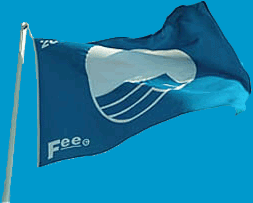FAQ
-
How does the Blue Flag assist the tourism sector and how does it help to improve the coastal environment? (Peter, South Africa)The Blue Flag has a double role in the coastal tourism sector. Firstly, the criteria demand good practices regarding water quality, environmental management, safety & services and environmental education. Through these means, the programme helps to improve the environmental quality of the coastal zone, and the behaviour of people working in or using these areas through education and awareness. On the other side, a municipality who applies for the Blue Flag and meets these criteria may then fly the flag, thus displaying their good environmental practices as a way to promote their destination.
-
What audit system is in place to ensure that FEE standards are always uphled? (D. Tobin, Ireland)For the Blue Flag programme, the beaches and marinas that apply for the award go through a series of control points. The first is during the application period, when the sites are reviewed by first a national jury (made up of experts within the country, you can see the composition on the website) and then an international jury. Then if the site is awarded with the flag, they are visited at least once a year by a national controller who will assure that all criteria are being met. Every year about 10-15% of the sites are also visited by an international controller. If there are non compliances, then the flag is removed until they are fixed, or for the rest of the season, depending on the severity.
-
What is the definition of a "designated bathing area"? (Danny, UK)A "designated bathing area" is a bathing area that is officially selected to be a bathing area by the European Union (for EU countries) or the relevant national authorities (for non-EU countries). A designated bathing area within the EU must have a sampling program in place.
-
Are bathing water test results available for inspection? If so where? How current do they have to be for blue flag requirements to be met? (Godfrey, UK)The bathing water quality results are publicly available. Actually, it is one of the imperative Blue Flag criteria to have information about the bathing water quality results posted at the beach. The results are furthermore available at the national Blue Flag co-ordinator and/or in the national ministry of environment/health.
Basis for applying for Blue Flag for a coming season is the demand that the results from previous season must be in full compliance with the strict requirements in the Blue Flag criteria. Furthermore, the results from tests during the season are also taken into account in the continuous evaluation of compliance with the criteria. Should it during the season happen that a beach has so bad bathing water quality results that it can no longer comply with the requirements, the Blue Flag will be withdrawn immediately. -
Which bathing water quality samplings are basis for the Blue Flag award? (Alvaro, Portugal)The Blue Flag award is both based on all the bathing water quality results of the previous year and of the current year of the award. This means that only beaches with excellent bathing water quality standards (the strictest EU standards) in the previous year will be eligible for the Blue Flag award.
Furthermore, awarded beaches will of course continue to have the bathing water quality controlled during the season, and if the water quality falls below the demands, the Blue Flag will be immediately withdrawn. -
Why are samples only taken at set points? Why is the testing only done during the summer period? Are the tests only carried out during high tide? (Tim, Ireland)The samples are taken at fixed points where the concentration of bathers are the highest and where there are potential pollution sources, like outside outlets (streams, etc.). The procedure therefore tries to give the worst case scenario (at the most important locations and at locations with highest chances for detecting pollution). The procedure in the Blue Flag Campaign exactly follows the procedures decided by EU legislation (the Bathing Water Directive).
The water quality sampling and analysis are quite expensive tests, and it is therefore in the EU Bathing Water Directive decided that the samplings should only be carried out throughout the whole bathing season when people are using the water for swimming.
The procedure for taking water samples again exactly follows the EU Bathing Water Directive - and is taken randomly in relation to tides. It is therefore not always taken at high tides, it is tried to ensure that the different samples at a sampling point are taken at different tides. -
Why is a Blue Flag beach not tested for toxic algae? (Camilla, Denmark)The water quality sampling and analysis exactly follow the requirements in the national and EU legislation. There are indirectly measures determining the presence of toxic algae at the Blue Flag beaches. In the required physico-chemical parameters, the transparency and water colour must be analysed. If there are any abnormalities, the beach will have the Blue Flag withdrawn. All Blue Flag beaches experiencing problems with algae blooms always have their Blue Flag temporarily withdrawn and information posted at the beach explaining the reason for the withdrawal. As an example, this happened at the West Coast of Jutland during an algae bloom in June 2000. If you therefore are bathing on a beach with the Blue Flag flying, there should not be presence of toxic algae endangering your health when bathing.
| Spiagge |
"
Spiagge Bandiere Blu 2025
"
Spiagge Bandiere Blu 2024
Spiagge Bandiere Blu 2023
Spiagge Bandiere Blu 2022
Spiagge Bandiere Blu 2024
Spiagge Bandiere Blu 2023
Spiagge Bandiere Blu 2022
| Approdi Turistici |
"
Approdi Bandiere Blu 2025
"
Approdi Bandiere Blu 2024
Approdi Bandiere Blu 2023
Approdi Bandiere Blu 2022
Approdi Bandiere Blu 2024
Approdi Bandiere Blu 2023
Approdi Bandiere Blu 2022
| Bandiera Blu delle Imbarcazioni |
| Progetto Pesca & Ambiente |
| Archivio News |
Nessuna notizia presente












